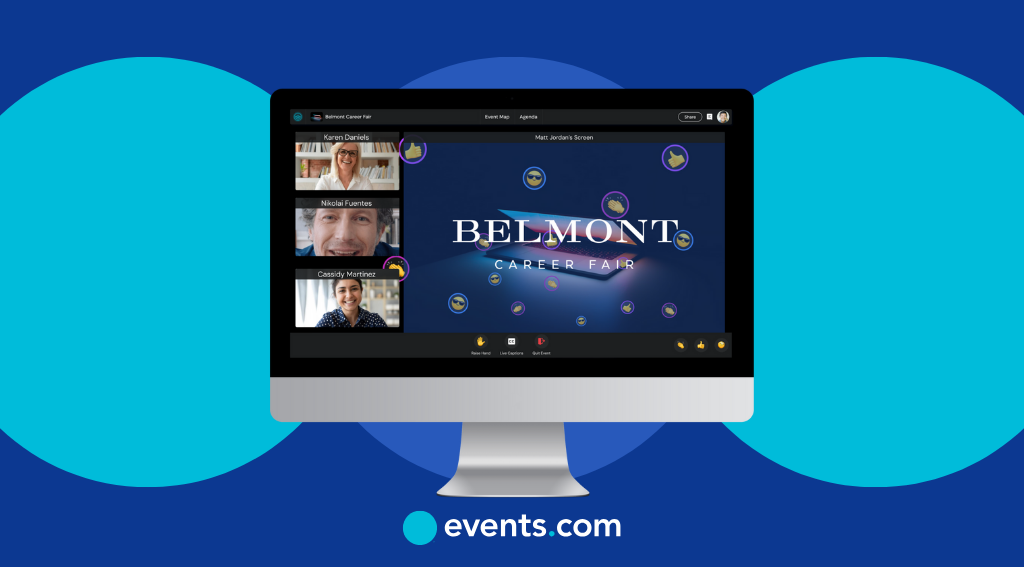Virtual events have evolved from a niche alternative to a mainstream strategy in the events industry. For event organizers and enthusiasts, understanding the range of virtual event types is key to creating engaging experiences that resonate with audiences. From trade shows to career fairs, there’s a format to fit just about any goal, audience, or budget.
In this article, we’ll break down why virtual events are so effective, look at some core formats, and highlight 10 highly successful event types you might want to consider for your next virtual event.
Why virtual events work
Virtual events have taken off and for good reason. They don’t just solve common event planning headaches; they also open up exciting new possibilities.
Here’s what makes them a breakthrough for the industry.
Cost-effectiveness and sustainability
Moving an event online drastically reduces venue expenses, travel, accommodation, and on-site logistics expenses. With far lower overhead, you can reach a large audience at a fraction of the cost and often see a higher return on investment.
Sustainability
Virtual events also come with a bonus: they’re far more sustainable. By reducing travel and waste, they significantly lower your carbon footprint, making them a smart choice for budget-conscious and eco-conscious planners.
Global reach and accessibility
Unlike in-person events that are tied to a specific location, virtual events are accessible from anywhere in the world. Attendees can join remotely, and with 24/7 on-demand access, it’s easier to accommodate different time zones and schedules. This level of inclusivity boosts participation and brings in more diverse audiences, making events broader in reach and deeper in impact.
Engagement and analytics insights
One of the biggest advantages of virtual events is the ability to track what’s working and what’s not in real time. Platforms like Events.com Virtual come with built-in tools that let attendees interact through live chat, polls, and Q&As, while also giving organizers access to detailed analytics. You can see who attended which sessions, how long they stayed, what they clicked, and even what content was downloaded. Features like intuitive dashboards make it easy to monitor engagement, spot drop-off points, and gather poll results. These insights are incredibly valuable as they help you fine-tune future events, create content that truly connects with your audience, and clearly show ROI to your team or stakeholders.
Hybrid and on-demand extensions
Virtual events add flexibility as sessions can be recorded and accessed anytime. Hybrid formats blend in-person and virtual experiences, making events more inclusive. This mix helps you reach more people, extend ROI, and keep content valuable long after the event ends.
With the benefits clearly in view, the next step is choosing the right format. Let’s explore the core virtual event styles that set the foundation for a successful experience.
Core virtual event formats
Virtual events aren’t limited to just one format . They can be live, on-demand, or a mix of both. The format you choose shapes the experience, so it’s all about what fits your goals and audience best.
Live events
Live events happen in real time and include formats like webinars, expert panels, and fireside chats. They’re built for interaction, giving attendees a chance to ask questions, vote in polls, or join the conversation through live chat. Platforms like Events.com Virtual make it easy to manage everything with tools for chat moderation, speaker controls, and built-in engagement features.
Global “round-the-clock” events
These events follow a rolling schedule across time zones, making them ideal for global audiences. Content flows 24/7, and with automated scheduling and timezone-aware reminders from Events.com Virtual, attendees stay informed and engaged, wherever they are.
On-demand events
On-demand events feature pre-recorded sessions that attendees can watch whenever it suits them. It’s all about convenience, especially for people juggling packed schedules or tuning in from different time zones. You can organize content into curated libraries and control access through secure, gated options, keeping everything streamlined and professional. Since there’s no live component, interaction is minimal, and each attendee experiences the content individually, on their own time.
Simulive events
Simulive offers a smart balance. You get the polished feel of pre-recorded content but with the real-time energy of live chat. Sessions play “as live,” so attendees can watch together, engage in the moment, and join the conversation. Events.com Virtual makes it super smooth with scheduled playback, chat moderation tools, and archived transcripts, so nothing gets lost. It’s structured and planned, but it still feels spontaneous. Unlike on-demand, simulive events create a more scheduled, communal experience, merging pre-recorded reliability with live interaction to simulate a real-time event.
10 specialized virtual event types
From networking and education to product launches and entertainment, nearly every type of event can be adapted and thrive in a virtual format. Here are ten proven virtual event types that deliver value, engagement, and real results.
- Virtual trade shows: Virtual trade shows bring the exhibit hall experience online, with interactive digital booths, product demos, and built-in lead capture tools. They’re a great way for brands to showcase what’s new and connect directly with buyers without the logistics of a physical venue. For example, a major e-commerce company hosts a virtual showcase, drawing in thousands of attendees from around the world.
- Virtual career fairs: Virtual career fairs make it easy for employers and job seekers to connect from anywhere. These events feature virtual booths, resume uploads, and 1:1 video chats for real-time conversations. Organizations can use them to recruit across geographies without travel, and in the same way, universities can use this format to connect graduates with international firms.
- Virtual conferences and summits: With keynotes, breakout rooms, and panel discussions, virtual conferences and summits deliver multi-track sessions. Annual industry summits use this format to host thousands, offering parallel tracks for diverse interests. Many organizations that moved their conferences online often saw attendance surge thanks to global accessibility.
- Virtual workshops and training: These are interactive classes or seminars conducted online with live instruction, exercises, and Q&A; ideal for certifications and skill-building. For example, instructors can deliver a virtual professional certification workshop to train participants in multiple locations with real-time feedback.
- Virtual networking mixers and happy hours: Virtual networking events create a relaxed space for people to connect through video chats, breakout rooms, icebreaker games, or speed networking sessions. Companies often host happy hours, while industry groups organize mixers over virtual coffee to help professionals build relationships in a casual setting. Some organizers even send out themed kits beforehand to make the experience feel a little more personal and fun.
- Virtual product launches and demos: Virtual product launches are all about visibility and real-time engagement. They often feature live unveilings, demo walkthroughs, and interactive Q&As that keep audiences involved from start to finish. Global tech brands often use this format to debut new gadgets via livestream, drawing massive engagement from viewers worldwide.
- Virtual hackathons and competitions: Virtual hackathons unite tech teams for fast-paced, collaborative problem-solving with team workspaces, real-time coding, and live judging. Global events use this format to guide teams from kickoff to final awards, all in a fully virtual setup.
- Virtual fundraisers and galas: Virtual fundraisers and galas move charity events online with livestreamed auctions, digital galas, and telethons. They’re accessible to supporters anywhere, easier to attend, and simple to share through email and social media, helping nonprofits reach new and existing donors without borders.
- Virtual concerts and entertainment: Whether it’s a music concert, comedy show, theater production, or cultural performance, these events are streamed live, or sometimes pre-recorded and broadcast as-live, to thousands of viewers. Artists and entertainers often interact with fans through live chat, Q&As, or virtual meet-and-greets, creating a more personal connection. These events are highly inclusive and shareable.
- Immersive AR/VR experiences: Immersive AR and VR events push the boundaries of digital engagement with 360° environments, interactive features, and gamified elements. Attendees can move through virtual spaces, interact with others, and experience events as if they’re physically there. From virtual art galleries to fully immersive conferences and concerts, these experiences blend creativity and technology in powerful ways. One example is a VR art exhibit that lets users use a VR headset to explore installations up close in a completely digital setting.
Choosing the right format
Choosing the right format depends on your goals and audience. Live formats work best for interaction; on-demand or simulive is ideal for content delivery. A global audience might prefer flexible viewing, while local attendees can join live sessions. New to virtual events? Start small. Try a webinar or meetup to test engagement and features. Use the insights to plan something bigger with confidence.
Best practices for virtual events
Executing a successful virtual event involves more than just logging on. Follow these practical tips:
- Test your tech: Before the event, test the platform, audio/video, screen sharing, and interactive tools. These rehearsals will iron out any issues and help prevent technical glitches.
- Promote and remind: Use email, social media, and your website to spread the word. As the event nears, send reminders with clear joining instructions and time zone info.
- Keep attendees engaged: Avoid “Zoom fatigue” by mixing in live polls, Q&As, and breakout rooms to keep things interactive and keep sessions short with breaks.
- Use analytics and feedback: Leverage the analytics dashboard offered by Events.com Virtual to monitor key metrics and iterate based on what works.
Ready to go virtual? Let’s make it happen.
Virtual events are a smart, scalable way to connect with audiences anywhere. With the right mix of format, planning, and tech, they can be just as impactful as in-person gatherings, sometimes even more. Ready to see what’s possible? Book a free demo with Events.com Virtual and start building events that go beyond boundaries.
Frequently asked questions about virtual events
1. Are virtual events only effective for large audiences?
No. Virtual events scale easily and can be just as effective for small, targeted groups.
2. How do I start with a virtual event on a small budget?
Begin with a simple live or on-demand event using cost-effective features of Events.com Virtual. Pilot with a small audience to test and refine your approach.
3. How do you keep attendees engaged?
Interactivity is key—use polls, Q&As, chat, and breakout rooms. Also, keep sessions concise and content relevant.
4. How do I decide between virtual, hybrid, or in-person?
Choose based on your goals and audience. Go virtual for reach and convenience, in-person for hands-on interaction, and hybrid to offer both. A quick audience survey can help you decide.







